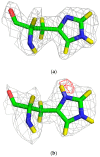A Review of the Catalytic Mechanism of Human Manganese Superoxide Dismutase
- PMID: 29385710
- PMCID: PMC5836015
- DOI: 10.3390/antiox7020025
A Review of the Catalytic Mechanism of Human Manganese Superoxide Dismutase
Abstract
Superoxide dismutases (SODs) are necessary antioxidant enzymes that protect cells from reactive oxygen species (ROS). Decreased levels of SODs or mutations that affect their catalytic activity have serious phenotypic consequences. SODs perform their bio-protective role by converting superoxide into oxygen and hydrogen peroxide by cyclic oxidation and reduction reactions with the active site metal. Mutations of SODs can cause cancer of the lung, colon, and lymphatic system, as well as neurodegenerative diseases such as Parkinson's disease and amyotrophic lateral sclerosis. While SODs have proven to be of significant biological importance since their discovery in 1968, the mechanistic nature of their catalytic function remains elusive. Extensive investigations with a multitude of approaches have tried to unveil the catalytic workings of SODs, but experimental limitations have impeded direct observations of the mechanism. Here, we focus on human MnSOD, the most significant enzyme in protecting against ROS in the human body. Human MnSOD resides in the mitochondrial matrix, the location of up to 90% of cellular ROS generation. We review the current knowledge of the MnSOD enzymatic mechanism and ongoing studies into solving the remaining mysteries.
Keywords: anti-oxidant; catalysis; human; manganese; mechanism; mitochondria; reactive oxygen species; superoxide dismutase.
Conflict of interest statement
The authors declare no conflicts of interests.
Figures





Similar articles
-
Managing odds in stem cells: insights into the role of mitochondrial antioxidant enzyme MnSOD.Free Radic Res. 2016;50(5):570-84. doi: 10.3109/10715762.2016.1155708. Free Radic Res. 2016. PMID: 26899340 Review.
-
Redox manipulation of the manganese metal in human manganese superoxide dismutase for neutron diffraction.Acta Crystallogr F Struct Biol Commun. 2018 Oct 1;74(Pt 10):677-687. doi: 10.1107/S2053230X18011299. Epub 2018 Sep 21. Acta Crystallogr F Struct Biol Commun. 2018. PMID: 30279321 Free PMC article.
-
Superoxide dismutases: role in redox signaling, vascular function, and diseases.Antioxid Redox Signal. 2011 Sep 15;15(6):1583-606. doi: 10.1089/ars.2011.3999. Epub 2011 Jun 6. Antioxid Redox Signal. 2011. PMID: 21473702 Free PMC article. Review.
-
Substrate-analog binding and electrostatic surfaces of human manganese superoxide dismutase.J Struct Biol. 2017 Jul;199(1):68-75. doi: 10.1016/j.jsb.2017.04.011. Epub 2017 Apr 29. J Struct Biol. 2017. PMID: 28461152 Free PMC article.
-
Manganese rescues adverse effects on lifespan and development in Podospora anserina challenged by excess hydrogen peroxide.Exp Gerontol. 2015 Mar;63:8-17. doi: 10.1016/j.exger.2015.01.042. Epub 2015 Jan 20. Exp Gerontol. 2015. PMID: 25616172
Cited by
-
Oxidative Stress in Primary Bone Tumors: A Comparative Analysis.Cureus. 2022 May 25;14(5):e25335. doi: 10.7759/cureus.25335. eCollection 2022 May. Cureus. 2022. PMID: 35761917 Free PMC article.
-
Effect of Diacetylcurcumin Manganese Complex on Rotenone-Induced Oxidative Stress, Mitochondria Dysfunction, and Inflammation in the SH-SY5Y Parkinson's Disease Cell Model.Molecules. 2024 Feb 22;29(5):957. doi: 10.3390/molecules29050957. Molecules. 2024. PMID: 38474469 Free PMC article.
-
Understanding the Factors That Influence the Antioxidant Activity of Manganosalen Complexes with Neuroprotective Effects.Antioxidants (Basel). 2024 Feb 22;13(3):265. doi: 10.3390/antiox13030265. Antioxidants (Basel). 2024. PMID: 38539799 Free PMC article.
-
Involvement of ROS signal in aging and regulation of brain functions.J Physiol Sci. 2025 Mar;75(1):100003. doi: 10.1016/j.jphyss.2024.100003. Epub 2024 Dec 21. J Physiol Sci. 2025. PMID: 39823967 Free PMC article. Review.
-
Preparation and Properties of Calcium Peroxide/Poly(ethylene glycol)@Silica Nanoparticles with Controlled Oxygen-Generating Behaviors.Materials (Basel). 2025 May 30;18(11):2568. doi: 10.3390/ma18112568. Materials (Basel). 2025. PMID: 40508566 Free PMC article.
References
Publication types
Grants and funding
LinkOut - more resources
Full Text Sources
Other Literature Sources

